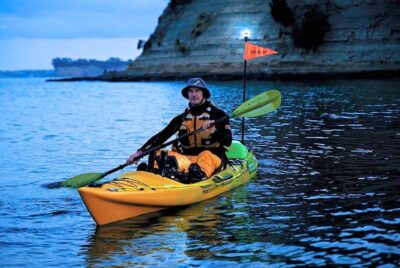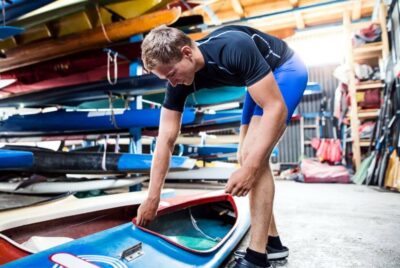Kayak Rack Guide: Enhance Your Journey
Kayaking, for me, started as a single experience and quickly turned into a passion. The calm of the water, the thrill of the paddle, and the sense of freedom that comes with every journey—it’s a feeling that’s hard to put into words. But I can tell you this, having the right gear, including a reliable kayak rack, makes the experience even better.
What is a Kayak Rack?
A kayak rack is a specially designed carrier that attaches to your vehicle and allows you to transport your kayak safely and securely. These racks come in various styles and designs, including roof-mounted, hitch-mounted, and truck bed racks. See below for more information.
Difference between Kayak Racks and Kayak Trailers
While both kayak racks and kayak trailers serve the purpose of transporting your kayak, they do so in distinct ways and each comes with its own set of advantages and disadvantages.
A kayak rack attaches directly to your vehicle, either on the roof, hitch, or truck bed. This makes racks a more compact solution, ideal for those who have limited storage space or wish to maintain their vehicle’s maneuverability. However, loading a kayak onto a rack, especially a roof-mounted one, can be physically demanding.
On the other hand, a kayak trailer is a separate wheeled unit that attaches to your vehicle’s hitch and trails behind it. Trailers can typically carry more kayaks and are easier to load, as you only need to lift the kayak to waist height. They can also often accommodate other types of watercraft, like canoes or paddleboards. However, trailers are more expensive, require extra storage space, and can affect your vehicle’s handling.
Why a Good Kayak Rack Matters
Whether you’re a seasoned kayaker or just starting out, having a good kayak rack is not just a matter of convenience—it can significantly impact your entire kayaking experience. A good rack securely holds your kayak during transit, keeping it safe from damage and ensuring you have a smooth journey to your paddling destination.
Safety Considerations
The importance of safety when transporting your kayak can’t be overstated. A high-quality kayak rack securely fastens your kayak to your vehicle, minimizing the risk of it falling off during transit. This not only prevents potential damage to your precious kayak but also eliminates the chance of causing road accidents. A poorly secured kayak can become a hazardous projectile on the road, posing a danger to you and other motorists. Therefore, investing in a good kayak rack is an investment in safety.
Convenience and Accessibility
Next to safety, convenience is one of the major reasons why a good kayak rack is essential. The right rack will make the process of loading and unloading your kayak a breeze, saving you time and energy that could be better spent on the water. In addition, a quality rack allows for easy accessibility to your kayak, making your trips to and from the water less of a chore and more of the exciting adventure they should be.

Types of Kayak Racks
As with any piece of equipment, not all kayak racks are created equal. There are different types to choose from, each with its own set of advantages and disadvantages. It’s important to understand these differences to make an informed decision.
Roof-Mounted Racks
Pros and Cons
Roof-mounted racks are perhaps the most common type of kayak rack. They attach to the roof of your vehicle and can usually hold one or two kayaks. The main advantage of roof-mounted racks is their compatibility with a wide variety of vehicles. Whether you drive a compact car or a larger SUV, chances are there’s a roof-mounted rack that will fit.
However, roof-mounted racks do have their drawbacks. They can be difficult to load, especially for shorter individuals or those with heavier kayaks. Lifting a kayak onto the roof of your vehicle can be a challenging task that requires strength and balance. Additionally, a loaded roof rack can increase wind resistance while driving, which may affect your vehicle’s fuel efficiency.
Hitch-Mounted Racks
Pros and Cons
Hitch-mounted racks attach to the hitch receiver at the rear of your vehicle. They sit much lower than roof-mounted racks, making them easier to load. This can be a significant advantage if you have a larger kayak or if you frequently go kayaking alone.
On the downside, a hitch-mounted rack can limit access to the rear of your vehicle. This could be a problem if you often need to open your trunk or hatchback. Additionally, not all vehicles have a hitch receiver, and installing one can be expensive.
Truck Bed Racks
Pros and Cons
Truck bed racks are designed specifically for pickup trucks. They typically hold the kayak above the bed of the truck, allowing you to utilize the bed for additional storage. This type of rack is great for easy loading, as you don’t have to lift the kayak as high.
However, like hitch-mounted racks, truck bed racks can limit access—to the truck bed in this case. If you frequently use your truck bed for other purposes, this could be a significant disadvantage. Additionally, truck bed racks are not suitable for people who don’t own a pickup truck.
Key Features to Look For in a Kayak Rack
When shopping for a kayak rack, there are several key features you should consider to ensure you choose a rack that suits your needs and delivers value for money.
Material and Build Quality
The material and build quality of your rack is crucial for its durability and longevity. Look for racks made from rust-resistant metals like aluminum or stainless steel, as these can withstand the elements and won’t corrode over time. The use of strong plastics in non-structural parts can also contribute to the overall durability of the rack. Be sure to check for good welding and assembly quality, too—a rack is only as strong as its weakest link.
Ease of Installation
Nobody wants to spend hours trying to fit a rack onto their vehicle. That’s why ease of installation is such an important feature to consider. The best racks come with clear, easy-to-follow instructions and require minimal tools for assembly. Some even feature a “tool-free” installation, which can save you a lot of time and hassle. Also, consider whether the rack is easy to remove when not in use, as you may not want it attached to your vehicle at all times.
Compatibility and Versatility
A good rack should not only fit your vehicle but also accommodate your kayak. Check the specifications of the rack to ensure it’s compatible with both your vehicle model and the size and weight of your kayak. A versatile rack that can carry different types of kayaks can be a great investment, especially if you own or plan to own multiple kayaks of different sizes or styles.
Keep in mind that some racks may require additional accessories or adapters to fit certain vehicles or kayaks, so factor this into your decision-making process. A rack may seem like a bargain until you realize you need to buy a bunch of extras to make it work with your setup.
Conclusion: Choosing the Best Kayak Rack for Your Needs
Choosing the right kayak rack can feel like a daunting task given the plethora of options available. However, by considering your specific needs and the factors we’ve discussed—safety, convenience, type of rack, material and build quality, ease of installation, and compatibility—you can make an informed decision. Remember, the goal is to find a rack that can safely and securely transport your kayak, making your trips to the water as smooth and hassle-free as possible. In the end, the best kayak rack is the one that enhances your overall kayaking experience and allows you to focus on the joy of the sport.
Frequently Asked Questions
Q: Can I install a kayak rack myself, or should I get professional help?
A: The ability to install a kayak rack yourself largely depends on the rack’s design and your handyman skills. Many racks are designed for easy installation and come with comprehensive instructions. These can typically be installed with common household tools. However, if the installation process seems too complicated or you’re not comfortable doing it yourself, it’s best to seek professional help. Safety is paramount, and a poorly installed rack can lead to accidents.
Q: What if my preferred kayak rack isn’t compatible with my vehicle?
A: If your preferred kayak rack isn’t compatible with your vehicle, you may need to consider other options. Some manufacturers offer adapter kits that can make a rack compatible with different vehicles, but these can vary in effectiveness. Alternatively, you can look for a similar style of rack from a different manufacturer that fits your vehicle.
Q: Can I use a kayak rack for other water sports equipment?
A: Many kayak racks are versatile and can be used to transport other types of water sports equipment, such as paddleboards or surfboards. However, this depends on the design and capacity of the rack. Always check the manufacturer’s guidelines to ensure safe and proper use.
Q: How should I maintain my kayak rack to ensure its longevity?
A: Maintaining your kayak rack involves regular cleaning, particularly after trips to saltwater locations, as salt can cause corrosion. Inspect the rack regularly for any signs of wear or damage, and tighten any loose components. Some racks may benefit from occasional lubrication of moving parts. Always follow the manufacturer’s maintenance instructions to keep your rack in good condition.
Q: Is it necessary to remove the kayak rack when not in use?
A: Whether you should remove your kayak rack when it’s not in use depends on a few factors. If you regularly use your vehicle in low clearance areas, removing the rack can prevent damage. Some people also prefer to remove their rack to improve fuel efficiency or reduce wind noise. However, if none of these factors are a concern for you, it’s typically fine to leave the rack on. Just be sure to check it regularly for any signs of wear or damage.





